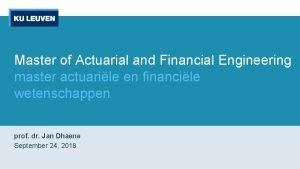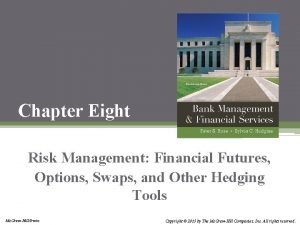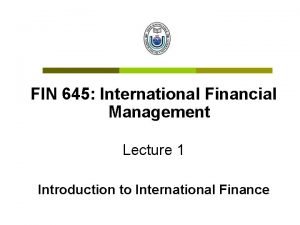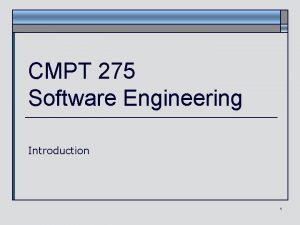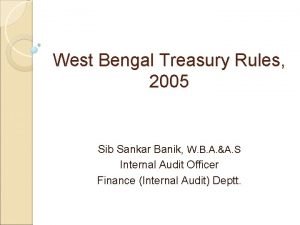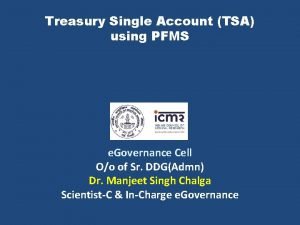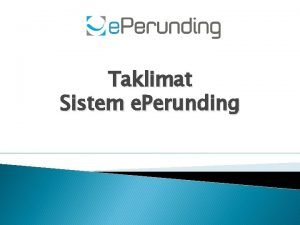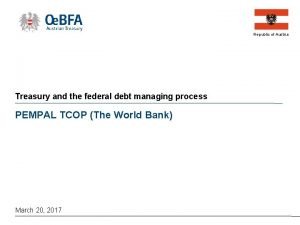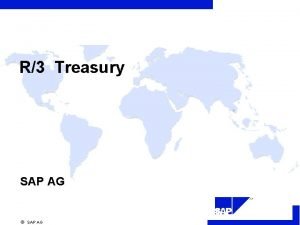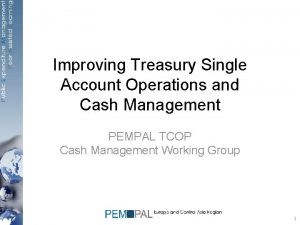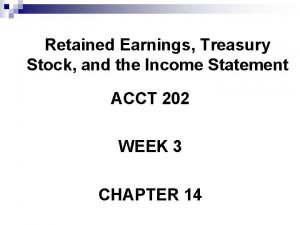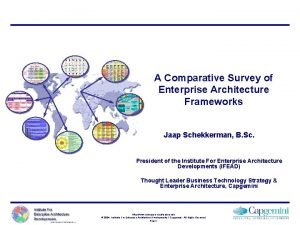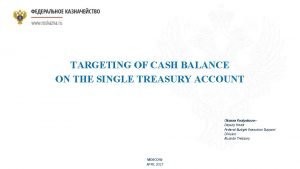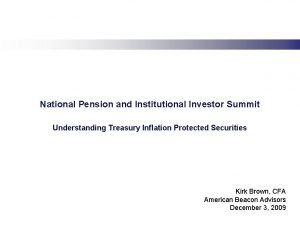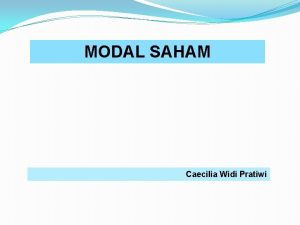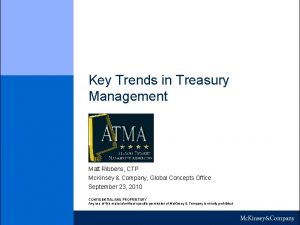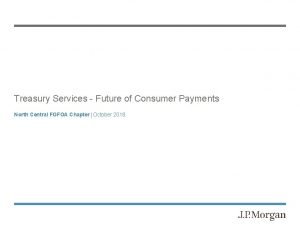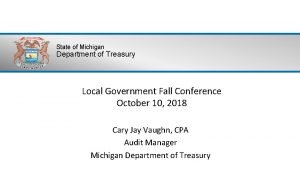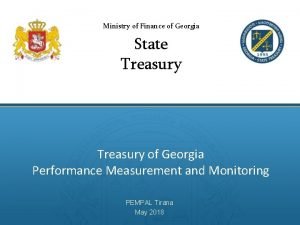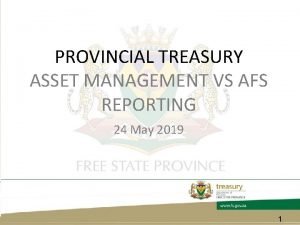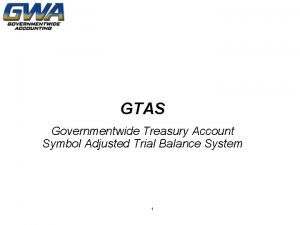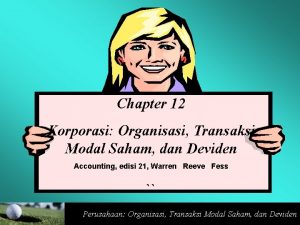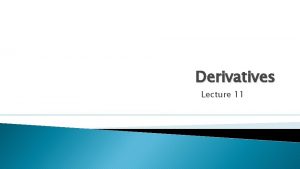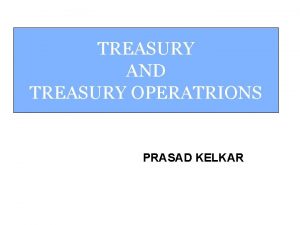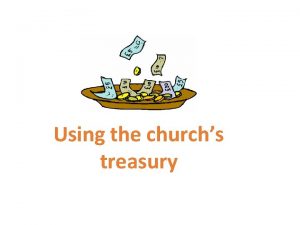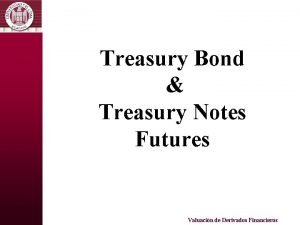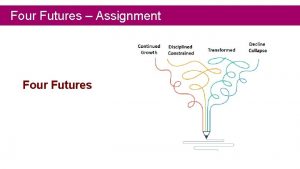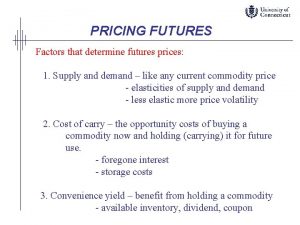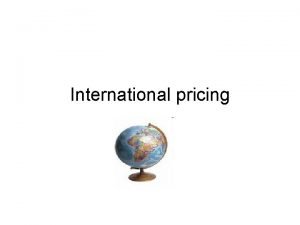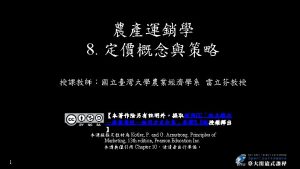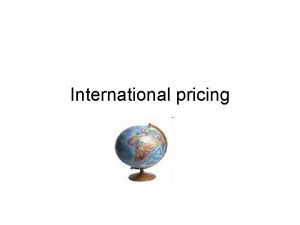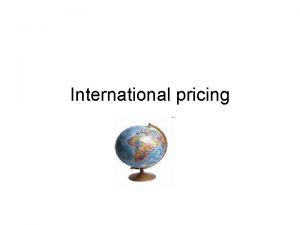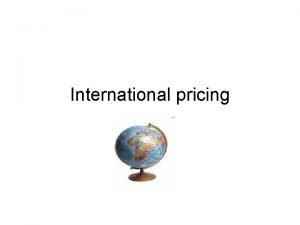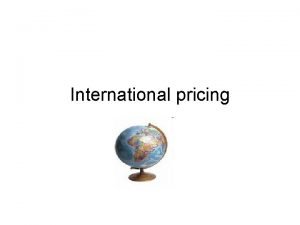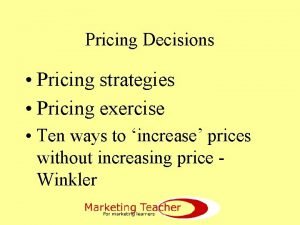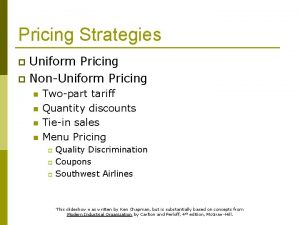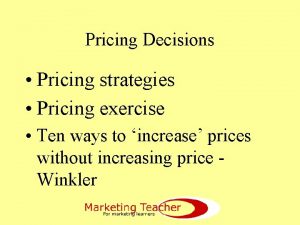Financial Engineering Lecture 7 Treasury Futures Topics Pricing












































- Slides: 44

Financial Engineering Lecture 7

Treasury Futures Topics Pricing Delivery Complications for both Multiple assets can be delivered on the same contract…unlike commodities The deliverable assets all have different prices

Treasury Futures Specs Copyright: CME Group 2019

Treasury Futures Pricing Cheapest to Delivery = Treasury futures allow the short position to select which bond to deliver (or sell) to the long futures position. The short will deliver the bond which is the least costly for the short position to purchase. This occurs since only 4 contracts are used to hedge all interest rate instruments. Thus, a real underlying asset does not exist. Certain bonds are “eligible” for delivery

Cheapest to Deliver Copyright: Bloomberg Financial Services 2015

Cheapest to Deliver Copyright: Bloomberg Financial Services 2015

Cheapest to Deliver Copyright: Bloomberg Financial Services 2015

Cheapest to Deliver Copyright: Bloomberg Financial Services 2015

Cheapest to Deliver Conversion Factor Bond prices vary for many reasons ◦ ◦ Higher coupons have higher prices Lower coupons have lower prices Longer maturities have higher prices Shorter maturities have lower prices If you deliver a more expensive bond, the amount you receive at delivery goes up If you deliver cheap bond, the amount you receive at delivery goes down

Cheapest to Deliver Quoted price = Price of the bond as quoted in the paper Accrued interest = amount of coupon earned on a bond since the last coupon payment Bond Cash Price = (Quoted price of bond X notational amount) + accrued interest Invoice Amount = Amount of money that is exchanged when a futures contract bond is delivered

Accrued Interest

Bond Price & Accrued Interest Example What is the cash price of a bond that pays a 4% semiannual coupon and matures in 12 years and three months, if the YTM is 6. 5%? Price FV = 1000 Pmt = 20 int = 3. 25 n = 24. 50 Solve for PV = $781. 20 Quoted Price = 78. 12

Bond Price & Accrued Interest Example (continued) What is the cash price of a bond that pays a 4% semiannual coupon and matures in 12 years and three months, if the YTM is 6. 5%? Accrued Interest Bond Cash Price

Treasury Futures Pricing Conversion Factor Since the bond we deliver is not specified in the futures contract, the price of the bond must be standardized. The conversion factor converts the futures price into a settlement or invoice price. The conversion factor is the present value of $1 at YTM=6%, assuming coupons are paid semiannual. Repo Rate Difference between the conversion factor yield of 6% and the coupon on the bond.

Conversion Factor Used to convert futures prices to bond prices What is the cash price of a bond that pays a 4% semiannual coupon and matures in 12 years and three months, if the YTM is 6. 5%? Using exact dates on a HP 12 c provides 82. 824

Futures “Cash Price” Also called the Adjusted Futures price Cash Price = Futures Price x Conversion Factor Futures Price = Cash Price / Conversion Factor

Invoice Amount (also called Delivery Cost) Invoice Amount = Futures Price x Conversion factor x Contract Size + accrued Interest Total amount of money exchanged at delivery

Futures Price Calculation The price of a treasury futures contract. The price is merely the future value of the spot price of the treasury, less PV of the coupons. This assumes a flat yield curve. I = present value of coupons

Futures Price Example Compute the conversion factor of a bond with exactly 9 years to maturity a 5% coupon, paid semiannually, and a YTM of 4. 8%.

Futures Price Example (continued) Compute the quoted price of the bond with exactly 9 years to maturity a 5% coupon, paid semiannually, and a YTM of 4. 8%. Price FV = 1000 Pmt = 25 int = 2. 4 n = 18 Solve for PV = $1014. 48 Quoted Price = 101. 45

Futures Price Example (continued) Compute the price of the 9 month futures contract. Remember the next coupon payment will be made in 6 months.

Cheapest To Deliver How To Calculate Delivery Cost (steps) 1 - Look up the price (FP) 2 - Compute “Conversion Factor” (CF) 3 - CF x FP x (contract size) + (accrued interest) = Delivery cost

Cheapest to Deliver The CTD can be found three ways 1. Quoted Bond Price – (Futures Price x CF) 2. Invoice Amount (lowest) 3. Highest Repo Rate Also called the “Gross basis” Select the lowest Also called the “Delivery Cost” The interest rate earned by short selling a security and buying it back later.

Cheapest To Deliver Theoretical Futures Price (FP)? Accrued interest and others items 3 Ways to Derive CTD 1 – Highest Repo Rate (The security and buying it back later. ) interest rate earned by short selling a 2 - Calculate Futures Delivery Spot Price 3 - Cost of Delivery (“Gross Basis”)

Cheapest To Deliver Example Two bonds are eligible for delivery on the June 2012 T Bond Futures K 1 - 9. 875 Nov 38 2 - 7. 25 May 39 deliveries on 15 th of maturity month On June 12, you announce to deliver a bond

Cheapest To Deliver Q: If YTM = 5%, which will you deliver and what is its price? A: CF 9. 875 Nov 38 1. 51 7. 25 May 39 1. 17 Deliver 9. 875 Nov 38 Bond Price 171. 05 133. 09 FC Spot Price 113. 28 113. 75

Cheapest To Deliver Q: If YTM = 9%, which will you deliver & what is its price? A: CF 9. 875 Nov 38 1. 51 7. 25 May 39 1. 17 Deliver 7 1/4 May 39 Bond Price 108. 76 82. 36 FC Spot Price 72. 03 70. 39

Cheapest To Deliver Q: If YTM = 7% and the listed futures price is 110. 50, which bond is CTD? A: 9 7/8 Nov 38 CTD = 134. 39 - (110. 5 x 1. 51) = -32. 47 7 1/4 May 39 CTD = 103. 00 - (110. 5 x 1. 17) = -26. 29 Implied Repo Rate Cost of Carry

Hedge Ratio Determination 1 2 3 4 5 6 - The Duration Model Naive Hedging Model Conversion Factor Model Basis Point Model Regression Model Yield Forecast Model

Hedge Ratios Duration Model

Hedge Ratios Duration Model Your cash position is $1, 000 10% coupon, 26 year bonds, with YTM=12. 64% and duration of 8. 24 years. The 6%, 20 year, TBill has a duration of 10. 14 years, YTM=8. 5% The FC on this bond is priced at 96. 87 HR = 79. 98 x 8. 24 96. 87 x 10. 14 = 659. 04 =. 671 982. 26 (1, 000 / 100, 000) x. 671 = 6. 71 or 7 contracts

Hedge Ratios Duration Example In 3 months, you will receive $3. 3 mil in cash and must invest it for 6 months. The current 6 month rate is 11. 20%. You like that rate, and wish to lock it in. 6 month tbills have a. 50 duration, while 3 month bills have a. 25 duration. If the 3 month futures price is 97. 36, what number of Ks are required to lock in the rate? HR = 100 x. 5 = 2. 05 x (3. 3 /. 1) = 67. 8 contarcts 97. 36 x. 25

Hedge Ratios Naive Model HR = 1. 0 (all previous examples were naive hedges) Conversion Factor Model HR = conversion factor CF = Price of deliverable bond @ 6% YTM 100

Hedge Ratios Conversion Factor Model Example You own a $1 mil portfolio you wish to hedge. Your are considering a 3 month futures K. The bond that could be delivered against the contract is a 9. 5%(semiannual) bond with a 30 year maturity. The bond is callable in 15 years. How many Ks should you use to hedge the position? CF = 134. 30/100 = 1. 34 x (1 mil/. 1) = 13 contracts

Hedge Ratios Example - Conversion Factor Model You have a $1 mil portfolio, containing 21. 5 year 10 3/8 bonds. Price = 100. 5363 (YTM = 10 5/16) CTD 20 year, 8% bond has YTM = 10. 43 Create the hedge. Assume that in 6 months YTM on your portfolio rises to 12 % and YTM on CTD rises to 12. 217% Create a table showing your position/profit/loss

Hedge Ratios Example - Conversion Factor Model CF = PV of 5. 1875 @ 3% for 43 periods / 100 = 1. 52 x (1 mil/100, 000) = 15 Today 6 mths Cash Own $1 mil @ 100. 5363 ($1, 005, 363) Futures Short 15 K @ 79. 718 (given) + $1, 195, 770 Sell @ 87. 63 + $876, 301 (129, 062) buy 15 K @ 71. 07 (given) ($1, 066, 050) +129, 720

Hedge Ratios Basis Point Model BVCcash = $ change in value per basis point of cash position B = Relative yield volatility of cash to CTD = (Vcash / Vctd) BVCctd = $ change in value per basis point of CTD CFctd =conversion factor of CTD

Hedge Ratios Example YTM = 9% on semi-annual bonds Your cash portfolio consists $1 mil of 26 year 9 7/8 bonds, that have a yield volatility of. 60 Futures CTD is a 7. 25% 26. 5 year note with a yield volatility of. 50 Use the basis point model to create a hedge and show the position table for a 3 month time period and a change in YTM to 10%.

Hedge Ratios Basis Point Model Use Calculator bond functions for calculations

Hedge Ratios example - continued Cash value @ 9% = 108. 737 BVCcash = $107 (PV @ 9% - PV @ 9. 01) BVCctd = $86 B =. 6 /. 5 = 1. 20 CF =. 1. 16 (PV of CTD @ 6% / 100) HR* = ( 107 ) x 1. 20 ( 86 / 1. 16) = 1. 73 1 mil / 100, 000 x 1. 73 = 17 contracts

Hedge Ratios example - continued (10%) Today Cash Futures $1 mil @ 108. 737 -$1, 087, 370 17 K @ 82. 44 (given) +1, 401, 480 3 months (YTM = 10%) $1 mil @ 98. 82 +$ 988, 212 17 K @ 76. 45 (given) - $1, 299, 650 Net Position $101, 830 gain net gain of $2, 672 $99, 158 loss

Hedge Ratios example - continued Assume YTM = 8% Today Cash Futures $1 mil @ 108. 737 -$1, 087, 370 17 K @ 82. 44 (given) + 1, 401, 480 3 months (YTM = 8%) $1 mil @ 120. 30 +$ 1, 203, 034 17 K @ 89. 56 (given) - $1, 522, 520 Net Position $121, 040 loss net loss of $5, 376 $115, 664 gain

Hedge Ratios Regression Model HR = Covariance of Cash & Futures Variance of futures best model if HR =. 90, then we know that a $1 change in futures prices correlates to a $0. 90 change in cash value. requires constant monitoring because HR changes with duration

Hedge Ratios Yield Forecast Model Given various yield forecasts, the HR changes Term Structure can forecast yields HR = CVdiff / FCV diff Example Cash Value = 97. 94 & Futures = 72. 50 Forecasted YTM CV YTM FC 12. 65 11. 25 12. 85 11. 40 13. 55 12. 05 13. 75 12. 20 CV 101. 72 100. 14 94. 99 93. 62 FC 75. 06 74. 14 70. 37 69. 54 CVdiff 3. 77 2. 20 -2. 95 -4. 33 FCdiff 2. 56 1. 64 -2. 13 -2. 96 HR 1. 48 1. 34 1. 36 1. 47
 Master actuarial and financial engineering
Master actuarial and financial engineering Future price formula
Future price formula Financial engineering notes
Financial engineering notes Options futures and risk management
Options futures and risk management 01:640:244 lecture notes - lecture 15: plat, idah, farad
01:640:244 lecture notes - lecture 15: plat, idah, farad Financial management lecture
Financial management lecture Financial markets and institutions ppt
Financial markets and institutions ppt Cs 527
Cs 527 Software engineering important topics
Software engineering important topics Engineering drawing chapter 1
Engineering drawing chapter 1 Engineering management topics
Engineering management topics Engineering meeting topics
Engineering meeting topics Software engineering course syllabus
Software engineering course syllabus Pricing to win in software engineering
Pricing to win in software engineering Software engineering lecture notes
Software engineering lecture notes Foundation engineering lecture notes
Foundation engineering lecture notes Descriptive ethics
Descriptive ethics Treasury rules 2005
Treasury rules 2005 Treasury
Treasury Tsa module in pfms
Tsa module in pfms Eperunding treasury
Eperunding treasury Treasury report example
Treasury report example Sap treasury workstation
Sap treasury workstation Treasury performance metrics
Treasury performance metrics Treasury single account meaning
Treasury single account meaning Banking automation suite
Banking automation suite Treasury stock retained earnings
Treasury stock retained earnings Ifead
Ifead Treasury best practices
Treasury best practices Treasury cash balance
Treasury cash balance Cyber treasury mponline
Cyber treasury mponline Undersecretariat of treasury (turkey)
Undersecretariat of treasury (turkey) Abb treasury
Abb treasury Treasury inflation protected securities cfa
Treasury inflation protected securities cfa Contoh soal saham treasury metode nilai nominal
Contoh soal saham treasury metode nilai nominal Trends in treasury management
Trends in treasury management What is fxall
What is fxall Real time payment
Real time payment Uniform chart of accounts michigan
Uniform chart of accounts michigan Treasury activities definition
Treasury activities definition Georgia state treasury
Georgia state treasury Asset management framework national treasury
Asset management framework national treasury Estelle setan national treasury
Estelle setan national treasury Treasury account symbol
Treasury account symbol Karakteristik korporasi dalam akuntansi
Karakteristik korporasi dalam akuntansi
